| Article ID | Journal | Published Year | Pages | File Type |
|---|---|---|---|---|
| 6436863 | Chemical Geology | 2013 | 10 Pages |
â¢Time-resolved IR spectroscopy of U(VI) sorption kinetics with a sub-minute resolutionâ¢Monomeric U(VI) carbonate surface complex at low U(VI) surface concentrationâ¢Oligomeric U(VI) surface complex at intermediate U(VI) loading on Al2O3â¢U(VI) surface precipitation at high U(VI) surface accumulation
The surface reactions of U(VI) on γ-Al2O3 were comprehensively investigated by a combined approach of in situ vibrational spectroscopy and X-ray absorption spectroscopy. The focus was set to micromolar U(VI) concentrations and a variety of sorption parameters which are relevant to most environmental scenarios, such as pH, ionic strength, different aluminum oxides, and solid-to-liquid ratios. Time-resolved IR spectroscopic sorption experiments at the alumina-water interface evidence the formation of three different species as a function of surface loading: a monomeric carbonate surface complex, an oligomeric surface complex, and a surface precipitate. EXAFS experiments of batch sorption samples different in their U(VI) surface loading, provided consistent results. Aluminum oxides and oxyhydroxides represent an essential structural component of many minerals and play a decisive role in regulating the mobility of contaminants in rocks and soils. Thus, the results presented in this study are of interest for the assessment of water contamination characterized by near neutral solutions. Additionally, the molecular-scale knowledge of the sorption reactions occurring at the water-alumina interface substantiates basic thermodynamic ideas of the formation and transition of surface complexes from sorption of monomers and oligomers to surface precipitation.
Graphical abstractDownload full-size image
